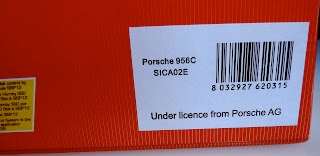Tail End of the Group C Porsche 956
Despite their age, the Porsches remained competitive throughout the Group C / GTP era. In slightly revised Dauer-Porsche form the 962 took another Le Mans win in 1994; a dozen years after it was first conceived. Needless to say the Porsche 956/962 has gone into history as one of the finest racing cars ever constructed.
The very first Porsche 956 made its racing debut at the Silverstone 6 Hour race in May of 1982 and was driven to class victory by Jackie Ickx and Derek Bell. During Le Mans, chassis 001 served as a T-car. Subsequently it was raced only once more, to victory at the Norisring by Jochen Mass. In the Summer of 1986, it was given to Ickx to thank him for many services for Porsches. After a lengthy stay in the United States, it recently ended up in the hands of a great Porsche and Group C racing enthusiast in Great Britain.Derek Bell is seen here back in one of 'his' old 956s during the 2007 Goodwood Festival of Speed, where the 25th anniversary of Group C was celebrated. (Source: Golden Era, the History of Group C & IMSA GTP, Ian Briggs and John Starkey)
Scalextric's Gemini Shell Porsche "Made in Gt. Britain" Main reason for the conception of the 962 was the stricter safety regulations of the IMSA series. The rules dictated that the pedal box had to be mounted behind the front axle line, to which the 956 did not comply. The 956 was a lot of things, but safe it sure wasn't, which is underlined by the fatal crash of one the day's biggest talents, Stefan Bellof. To make the 956 eligible for the IMSA's GTP series, the wheelbase was increased to make room for the pedal box. Further modifications included the addition of a steel rollcage.
 Five IMSA 962s were constructed for the 1984 season. Work was under way on a larger engine, but in the meantime the 934 derived 2.8 litre engine was used. In its first season the Holbert and Bell driven 962 scored four IMSA victories, a sign of things to come. For 1985 a 3.2 litre was available and the 962's stronghold on the IMSA GTP series was complete. Up until 1993 the 962 was successful in the IMSA GTP series, the 962's roll of honour includes 5 victorious in the gruelling Daytona 24 Hours race.
"Magnetraction" - Scalextric's exterior adjustable magnet, adjacent to the can in-line motor.
For the 1985 WEC (World Endurance Championship) the works team fielded a new car, the 962C. It was similar to the IMSA 962, but it featured the twin Turbo charged engine found in the 956. In the hands of talented drivers like Bell, Ickx and Stuck, the 962C dominated that year's championship. At Le Mans the 962Cs showed blistering pace in qualifying, but in the race they were outrun by the Joest entered 956, which scored the 956's fourth consecutive victory.
Scalextric's Porsche Racing - "Made in Gt. Britain"
The 1986 season was a carbon copy of the 1985 one, with the Porsche field now mostly made up of 962s. The name of the championship changed to WSPC (World Sports Prototype Championship), but the winner was the same! This time the works team was more successful at the 24 Hours of Le Mans. Although two of the three entered cars retired, the works was able to score victory with the remaining 962C.
Scalextric's Porsche Shell M2000 - "Made in Gt. Britain"
In 1988 the Jaguar team had truely taken over from Porsche, with the Sauber Mercedes team close on their tale. The six Le Mans victories and the many other major victories of the 956/962 were a fitting finale to Porsche's 20 years stronghold of sportscar racing. The 962 was victorious once more at Le Mans in 1994, with Porsche taking advantage of the large number of 962's produced, making it eligible for the new GT1 class.
Scalextric's Porsche Syntron-X - "Made in Great Britain"
Featured is a 962C, fitted with the 3 litre engine. It is pictured on the Spa Franchorchamps where it took part in the Group C revival race, which was part of the 2003 RMU Classic.
Article by Wouter Melissen
General specifications: Country of origin - Germany
Scalextrics Porsche Texaco Havoline - "MADE IN GT. BRITAIN" Chassis number 956/001 / 956/007 / 956/114
Numbers built - 27
Produced from - 1982 - 1985
Successor - Porsche 962C
Major wins
1982
24 Hours of Le Mans (Derek Bell / Jacky Ickx in 002)
1983
Nurburgring 1000 km (Jacky Ickx / Jochen Mass in 005)
1983
24 Hours of Le Mans (Al Holbert / Vern Schuppan / Hurley Haywood in 003)
1984
24 Hours of Le Mans (Henri Pescarolo / Klaus Ludwig in 117)
1984
Nurburgring 1000 km (Derek Bell / Stefan Bellof in 009)
1985
24 Hours of Le Mans (Paolo Barilla / Klaus Ludwig / John 'Winter' in 117)
Engine
Configuration Type 935/76 B 6 Location Mid, longitudinally mounted Weight 168 kilo / 370.4 lbs Construction aluminium block and head Displacement 2.65 liter / 161.7 cu in
Bore / Stroke 82.3 mm (3.2 in) / 66.0 mm (2.6 in) Valvetrain 4 valves / cylinder, DOHC Fuel feed Bosch Fuel Injection Aspiration Twin KKK Turbos
Drivetrain
Chassis/body aluminium monocoque, rear subframe
Front suspension double wishbones, coil springs over Bilstein gas-pressurized dampers Rear suspension rocker arms, coil springs over dampers
This is the DRIFT car, notice the rotational guide and braids.
Steering rack-and-pinion Brakes ventilated and cross drilled discs, all-round Gearbox 5 speed Manual Drive Rear wheel drive | 




















No comments:
Post a Comment